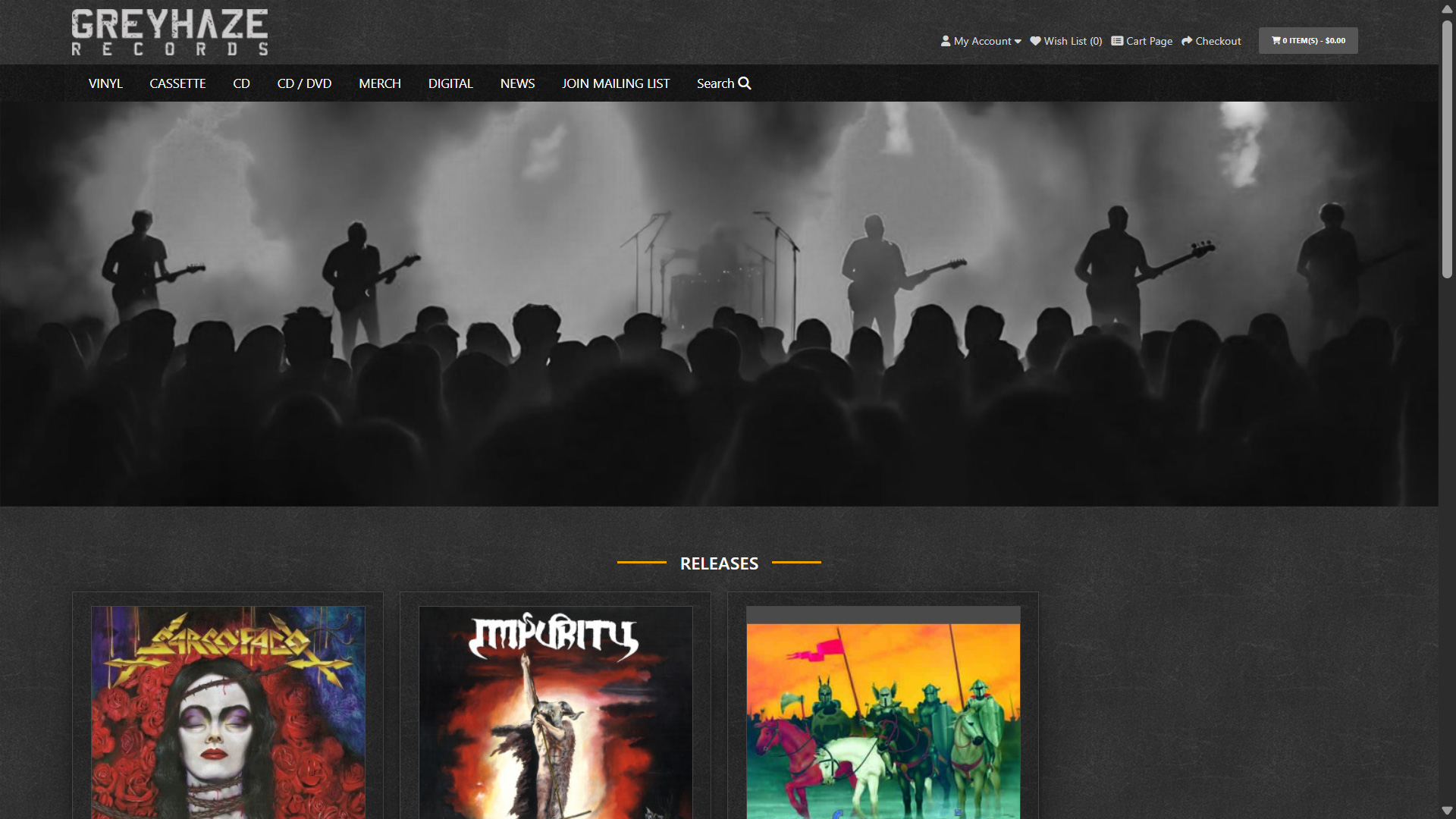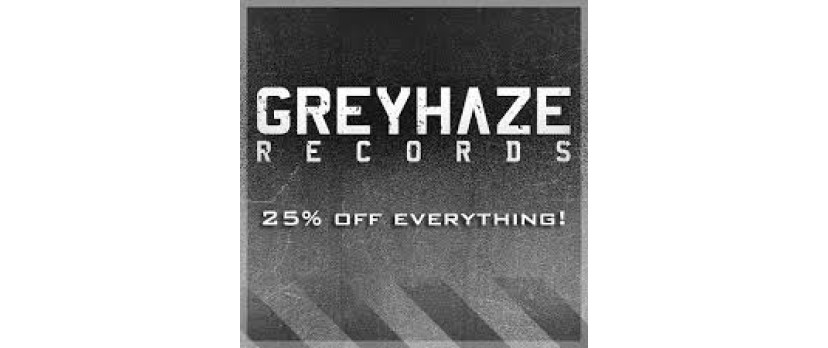Why Grey Haze Records Needed an Upgrade
Grey Haze Records had been running on OpenCart version 1.5.3.1 for over a decade. While the site was functional, it was increasingly difficult to maintain and lacked compatibility with modern tools, security protocols, and responsive themes. The technology landscape and customer expectations had changed significantly since that version was released in 2012.

Key Problems With the Old Version
Several limitations of OpenCart 1.5.3.1 were affecting the site's performance and manageability:
Security Vulnerabilities
Older versions of OpenCart no longer receive official updates. This left the store exposed to potential threats, especially given that many extensions and plugins were no longer supported.Lack of Mobile Responsiveness
The theme used was not mobile-friendly, making browsing and purchasing difficult on smartphones and tablets. With a growing share of users shopping on mobile, this became a priority concern.Extension Compatibility Issues
Many third-party modules used on the site were outdated or unsupported. The store was running patched custom code that made it harder to install new features or apply fixes without breaking something.Sluggish Performance
Over time, performance had degraded. Page loads were slower, and the admin panel became less responsive, especially when managing a growing product catalog.Search Engine Optimization (SEO) Limitations
The old version lacked features critical for modern SEO, such as structured data, canonical tags, and user-friendly URLs without extensions.
Strategic Motivation for Upgrading
Grey Haze Records wanted more than just stability—they needed flexibility for growth. They were preparing to invest in marketing, upgrade the visual experience, and improve checkout flow. But continuing with version 1.5.3.1 would limit those efforts or introduce risk with every change.
Upgrading to OpenCart 4.1.0.3 offered:
A modern admin interface
Support for PHP 8.x
Improved module and extension system
Better SEO and performance tools
Future-proofing for new security standards
In short, the upgrade wasn’t just about keeping the site alive it was about building a better foundation for the next phase of their business.
Initial Assessment of the OpenCart 1.5.3.1 Setup
Before any upgrade could begin, we needed to understand exactly what we were working with. Grey Haze Records had been using OpenCart 1.5.3.1 for years, and over that time, layers of custom code, outdated extensions, and manual fixes had accumulated. Skipping the assessment step would have risked data loss, broken functionality, or a failed migration.

Mapping the Store’s Architecture
The developer started with a full audit of the website’s structure:
Core OpenCart Files
Confirmed the version and checked for any core file modifications. It was important to know whether the original files had been altered, as these changes could conflict with the new version’s codebase.Theme and Template Files
The site was using a heavily customized theme that didn’t follow the standard OpenCart template structure. This made a direct upgrade impossible and signaled the need for a new theme compatible with OpenCart 4.Installed Extensions and Mods
A detailed list was created of every extension, module, and vQmod installed. Many were no longer supported or built for deprecated PHP versions. These would need alternatives or rewrites in the newer version.Product and Category Structure
The database was examined for custom fields, nested categories, and product attributes. Some inconsistencies like duplicate fields and missing meta data—were flagged for cleanup during the migration.User and Order Data
Admin users, customer accounts, and order histories were reviewed for accuracy and export compatibility. There were thousands of legacy records that had to be preserved, but only the necessary fields would be transferred to avoid clutter.
Preparing a Safe Staging Environment
Upgrading a live OpenCart store especially one with years of customizations is risky. Even a small mistake can bring the entire site down or cause data loss. That’s why building a secure, fully functional staging environment was the first critical step before touching anything in production.
Creating a Mirror of the Live Store
The developer started by creating an exact copy of the live site, including:
Files and Folders
All site files were duplicated and placed on a subdomain, like staging.greyhazerecords.com, to keep the environments isolated. This ensured no disruption to customer traffic during testing.Database Dump
A complete export of the MySQL database was made. It included all products, customer accounts, categories, orders, and custom fields.Hidden From Search Engines
The staging site was blocked from being indexed using a robots.txt directive and .htaccess authentication. This avoided duplicate content issues in search results.SSL and Permissions
SSL was installed on the staging site to replicate the HTTPS environment. File permissions were adjusted to match the live server, ensuring accurate testing conditions.
Setting Up OpenCart 4 in Parallel
Rather than overwrite the old version, OpenCart 4.1.0.3 was installed in a clean, separate directory. This allowed both versions to run side by side for comparison and migration tasks.
The new environment included:
Fresh OpenCart core installation
Updated PHP and MySQL versions compatible with OpenCart 4
Clean theme and default modules ready for configuration
Benefits of the Staging Setup
Having a dedicated staging environment made the upgrade safer and more controlled. It allowed:
Trial migrations without risk to live data
Testing of new modules and theme changes
Faster rollback if something broke
Ongoing store operations while development continued
Most importantly, it gave the team time and flexibility to test thoroughly something that’s often overlooked in rushed upgrades.
Handling Custom Themes and Extensions
One of the most complex parts of updating from OpenCart 1.5.3.1 to 4.1.0.3 was dealing with legacy customizations. Over the years, Grey Haze Records had added a wide range of visual tweaks, extension scripts, and back-end mods—many of which were not built for longevity. Simply copying them into the new version would break the site.
Assessing Theme Compatibility
The original theme was outdated, non-responsive, and incompatible with the Twig templating system introduced in newer OpenCart versions. After careful inspection, the developer found:
Legacy template files relied on .tpl syntax, which is no longer supported in OpenCart 4.
Custom CSS and JavaScript were directly embedded in templates instead of being modular or override-friendly.
Mobile responsiveness was limited or missing entirely.
Rather than attempt to convert the old theme line-by-line, the decision was made to start fresh with a new theme built for OpenCart 4. A modern, responsive design was selected and then lightly customized to retain key visual elements from the original site.
Evaluating Extensions and Modules
The extension audit revealed a mix of:
Obsolete vQmod scripts that conflicted with OpenCart’s new event-based system.
Hard-coded changes that couldn’t be cleanly ported to the new core.
Functional overlap across different modules some of which could now be handled natively in OpenCart 4.
To move forward, each extension was categorized:
This allowed the team to reduce clutter while preserving essential features.
Porting Custom Features
For the few critical functions that couldn’t be replaced with a ready-made module, the developer rewrote them as clean extensions using the current OpenCart API and event system. This ensured:
Compatibility with future updates
Cleaner codebase for easier maintenance
Better separation between core and custom logic
Examples of custom work included a label printing tool for shipments and a unique discount calculation engine based on order volume.
Testing the New OpenCart 4.1.0.3 Build
Once the new OpenCart environment was up and running, rigorous testing became the priority. This was the final opportunity to catch bugs, misconfigurations, or broken workflows before going live. The goal was simple: make sure everything worked as expected on both the frontend and backend without surprises.
Core Functionality Tests
The first stage focused on ensuring that the upgraded store could handle everyday operations:
Product Pages
Each product type (simple, configurable, and with custom fields) was reviewed for layout accuracy, pricing, tax rules, and images.Cart and Checkout Flow
The full purchase process was tested, including coupon application, shipping options, and guest vs. registered checkout paths.Admin Features
Product management, customer account controls, order status updates, and inventory rules were checked to verify back-end reliability.Multi-Language and Currency
As Grey Haze Records had international traffic, the multi-currency and multi-language settings were also tested to ensure accurate conversions and translations.
Extension and Theme Validation
Next came verifying that the installed extensions and the new theme worked in harmony:
Custom-built modules were stress-tested with real data.
Event-based extensions were checked for proper hook execution.
CSS and JS conflicts were tracked using browser dev tools and fixed early.
Any module that threw errors or produced layout issues was temporarily disabled until either a compatible version was sourced or a rewrite was completed.
Mobile and Cross-Browser Checks
A new theme means new behavior across devices. Testing included:
Mobile phones (iOS and Android) for navigation, touch controls, and layout collapse.
Desktop browsers (Chrome, Firefox, Safari, Edge) to verify consistent display and interactive elements.
Tablets, where screen resolution falls between breakpoints, often exposing hidden bugs.
Security and Performance Reviews
Before launch, security and performance were tested to avoid slowdowns or vulnerabilities:
Password reset flows, account creation, and admin access permissions were confirmed.
SSL enforcement and HTTPS redirection were checked.
Page load speeds were measured using tools like GTmetrix and Google PageSpeed Insights, with image compression and lazy loading enabled where needed.
Testing With Real Users
Finally, the site was opened to a small internal team for “real user” testing. These users were asked to:
Browse as regular customers
Place test orders
Report any errors, confusions, or slowdowns
This feedback loop revealed small issues like mislabeled buttons or missing microcopy that weren’t caught by automated checks but mattered for customer experience.
Going Live With Zero Downtime
After months of preparation, testing, and careful development, the final milestone was launching the new version of Grey Haze Records without causing service disruption. For an eCommerce site that processes live orders and traffic daily, even an hour of downtime could impact sales and customer trust. The developer's goal was a smooth switchover without customers ever knowing it happened.
Step 1: Schedule the Go-Live Window
The team chose a low-traffic time for the migration early morning on a weekday when sales volume was historically lowest. This minimized the risk of interrupting active users and gave enough breathing room in case issues emerged during deployment.
Step 2: Freeze the Live Database
To prevent data mismatches during the final sync, the developer temporarily placed the live store in maintenance mode. This stopped new orders, updates, or registrations while the latest data was extracted and transferred to the new OpenCart 4 database.
A message was shown to users explaining the brief pause in service.
The team notified support staff and admin users to avoid back-end changes during this period.
Step 3: Sync and Swap
The developer used the most recent copy of the live database and product images to populate the new version. Then:
The DNS was updated to point to the new server and document root.
All caches were cleared on the server and browser side.
SSL certificates were re-applied to ensure HTTPS worked without error.
Because everything had been rehearsed on staging including full restores and rollbacks the live switch only took about 20 minutes.
Step 4: Post-Launch Validation
Once the new site was live, a rapid-fire round of QA began. The checklist included:
Confirming that order emails and admin alerts were working
Running a real transaction with payment gateway
Browsing key categories and high-traffic products
Checking Google Analytics and Search Console for continued tracking
Reviewing server logs for 404s or unexpected redirects
Nothing major broke. A few small image links needed correcting, and one mobile menu animation was off but nothing mission-critical. Fixes were applied immediately.
Post-Upgrade Maintenance and Improvements
Going live wasn’t the end of the project it marked the start of a new phase: ongoing maintenance and continuous improvement. With OpenCart 4.1.0.3 successfully deployed, Grey Haze Records shifted its focus to keeping the store stable, fast, and optimized.
Monitoring and Early Bug Fixes
No launch is perfect. In the first few weeks, the team monitored error logs, customer support messages, and user behavior patterns to catch any missed issues.
Error Logs and Debugging
PHP and OpenCart error logs were reviewed daily to track warnings, notices, or failed module calls. Most of these were tied to edge-case order types or rare product configurations.Customer Feedback
A temporary feedback form was added to the footer, encouraging users to report broken links, confusing features, or missing content. Several minor UX issues were identified this way such as a misaligned filter menu on tablets and a product page missing shipping info.Analytics Monitoring
Google Analytics, Search Console, and Hotjar were used to monitor bounce rates, engagement time, and checkout drop-off. Any unusual shifts triggered a review.
Ongoing Maintenance Tasks
To keep the site running smoothly, a few maintenance routines were established:
Regular Backups
Automated backups were scheduled to capture both the database and site files daily, with weekly offsite storage to cloud storage for disaster recovery.Extension Updates
All third-party modules were checked monthly for compatibility updates or security patches. Version tracking was documented to simplify future upgrades.Performance Optimization
Caching settings, image compression, and database cleanup scripts were fine-tuned to maintain fast page load times. Lazy loading was added to collections with many products to reduce initial load strain.
Improvements Beyond the Upgrade
With the technical upgrade complete, Grey Haze Records had new opportunities to enhance both functionality and marketing:
New Features
Features that were previously too difficult to add like product reviews with image uploads, automated email reminders for abandoned carts, and dynamic filtering—were now possible.Admin Training
Staff received updated documentation and hands-on walkthroughs to navigate the new admin panel. This reduced errors and increased efficiency in managing orders and products.SEO Enhancements
Meta tags, canonical URLs, and structured data were reviewed and optimized, using OpenCart 4’s better SEO support and compatible plugins.
Final Touches and Client Outcome
With the new version of OpenCart fully deployed, we concluded the project by helping the store owner integrate PayPal for secure online payments and enable Fastlane Checkout to simplify the buying process for returning customers. These final additions not only enhanced the user experience but also aligned the site with modern eCommerce standards. Grey Haze Records now runs on a faster, more secure, and future-ready platform—ready to scale and serve its audience without the limitations of the past.


Login and write down your comment.
Login my OpenCart Account